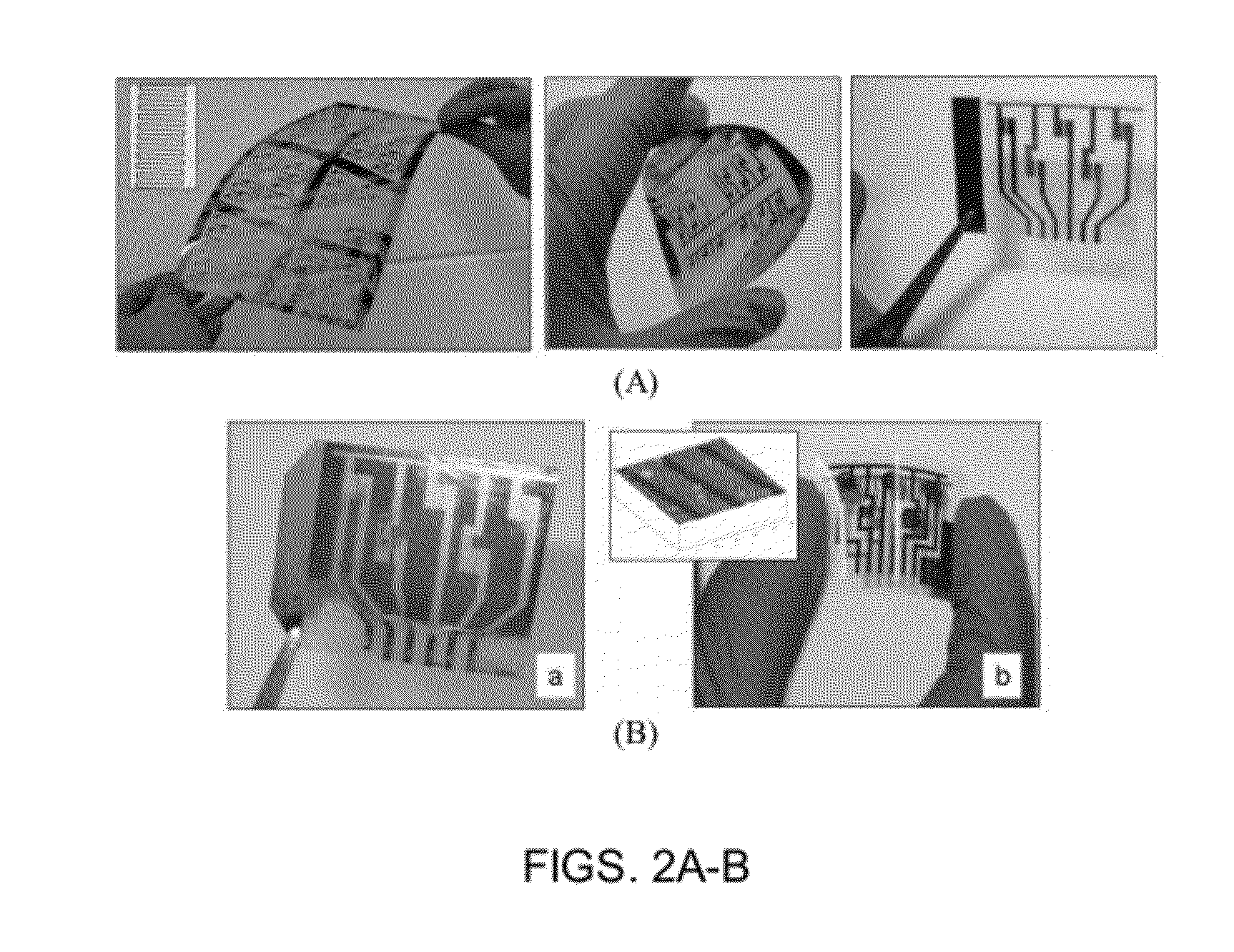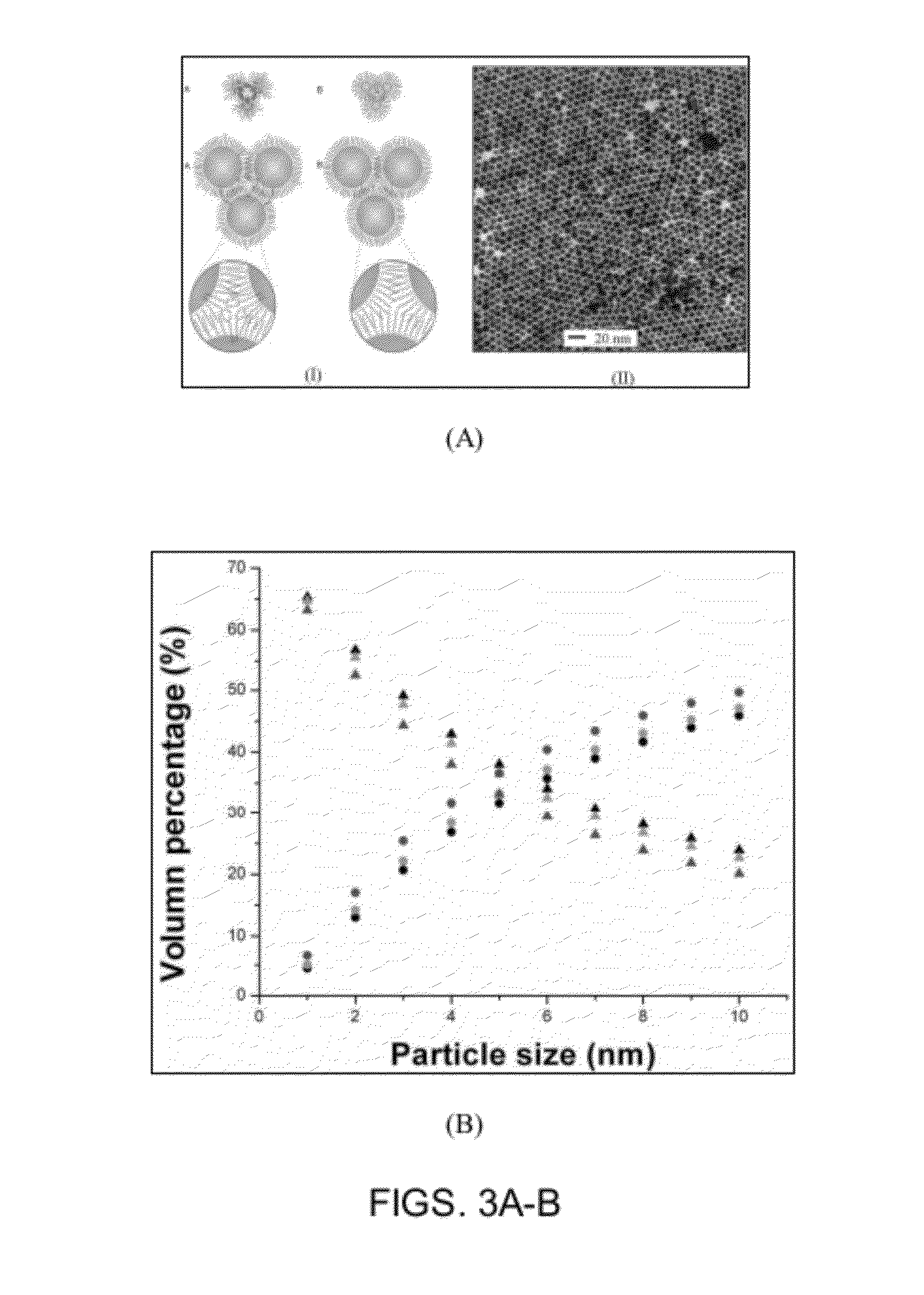Flexible multi-moduled nanoparticle-structured sensor array on polymer substrate and methods for manufacture
- Summary
- Abstract
- Description
- Claims
- Application Information
AI Technical Summary
Benefits of technology
Problems solved by technology
Method used
Image
Examples
example 1
[0206]In one embodiment, a flexible chemiresistor sensor comprises thin film assemblies of nanoparticles on polyethylene terephthalate substrate.
[0207]The thin film assembly of metal nanoparticles on flexible chemiresistor (CR) arrays can be used to address the versatility of chemical sensor design. In this example, thin film assemblies of gold nanoparticles in size range of 2-8 nm diameters with high monodispersity (unlinked or linked by molecular mediators) were assembled on an CR array with polyethylene terephthalate (PET) substrate to demonstrate the flexible chemiresistor characteristics of the nanostructured materials. The correlation between the relative change in electrical conductivity and the change in dielectric medium constant in response to flexible wrapping of the device demonstrated the viability of manipulating the electrical responses in terms of wrapping direction.
[0208]The responses of the devices in response to volatile organic compounds (VOCs) were analyzed in t...
example 2
[0249]In one embodiment, a flexible chemiresistor (CR) breach sensor array for detecting acetone in breath.
[0250]This example demonstrates the use of molecularly-mediated thin film assemblies on flexible devices as sensor arrays for detecting biomarkers for diabetic breath. This example also demonstrates a noninvasive device for diagnostic monitoring.
[0251]There is a significant market need for cost-effective medical devices for rapid diagnostics of diabetes and glucose monitoring. While different devices have been developed for detecting glucose levels in diabetic patients, there is a need in the art for diagnostic analysis of glucose level via breath detection, especially portable sensor devices. Glucose sensors coupled with insulin delivery pumps are well known in the art. Recently, a “pumpless” micropump has been developed. The working principle involves electrically-induced interfacial tension at the boundary of two immiscible liquids that produces actuation force. This is a lo...
example 3
[0286]Metal or alloy nanoparticles have attracted increasing interests as chemical or biological sensing materials for various electrical devices such as chemiresistors and piezoelectric resonators on rigid substrates. One example involves molecularly-mediated thin film assemblies of gold or alloy nanoparticles via interparticle covalent bonding, hydrogen-bonding, or van der Waals interaction on microelectrode patterned glass substrates. Recently, the study of functional devices on flexible substrates becomes an important focal area of interests. In comparison with conventional devices on rigid silicon, glass or ceramic substrates, the attributes of flexible devices include simplified processing, low-cost manufacturing, and increased flexibility for their integration in wraps, lightweight electronics packaging platform, and conformal adaptability in various complex or special sensing environment. There have been an increasing number of reports on flexible substrates for chemical sen...
PUM
 Login to View More
Login to View More Abstract
Description
Claims
Application Information
 Login to View More
Login to View More - R&D
- Intellectual Property
- Life Sciences
- Materials
- Tech Scout
- Unparalleled Data Quality
- Higher Quality Content
- 60% Fewer Hallucinations
Browse by: Latest US Patents, China's latest patents, Technical Efficacy Thesaurus, Application Domain, Technology Topic, Popular Technical Reports.
© 2025 PatSnap. All rights reserved.Legal|Privacy policy|Modern Slavery Act Transparency Statement|Sitemap|About US| Contact US: help@patsnap.com



